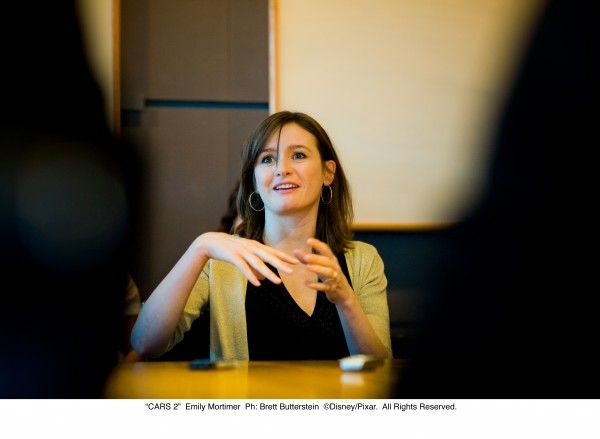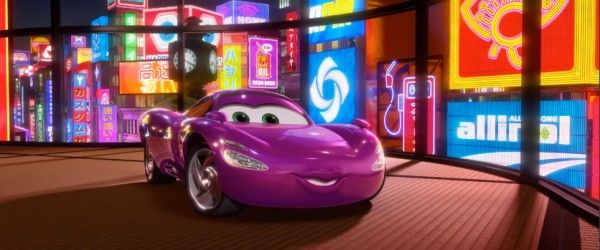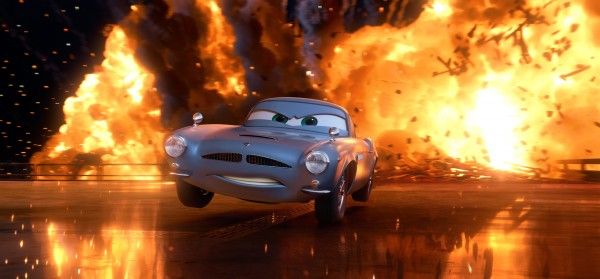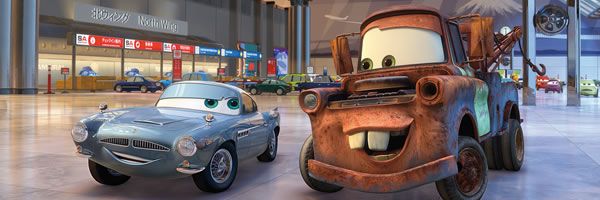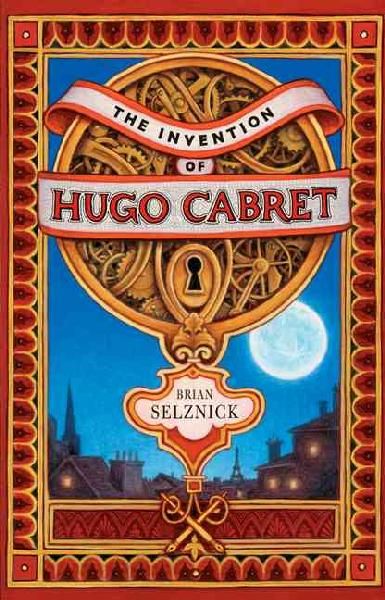Recently, we got the chance to talk to actress Emily Mortimer at the press day for Cars 2 at Pixar. In the sequel to the 2006 film, Mortimer voices the character of Holly Shiftwell, a beautiful British desk agent who is now a spy-in-training. She’s one of a cadre of new characters in the film, and works closely with international spy Finn McMissile, voiced by Michael Caine. Throughout the animated flick, Shiftwell interacts quite a bit with loveable towtruck Mater as the two must work together to solve a case of international espionage.During the course of our interview, Mortimer talked about how the process of voice-acting at Pixar works, what it was like to work with director John Lasseter, how the experience differed from her voice-work on Howl’s Moving Castle, and what it was like to re-team with director Martin Scorsese for his first 3D feature Hugo Cabret. Hit the jump to check out the full interview.First off, if you’ve missed any of our previous Cars 2 interviews here’s your chance to catch up:
- Producer Denise Ream
- Composer Michael Giacchino
- Story Supervisor Nathan Stanton
- Supervising Animators Shawn Krause and Dave Mullins
We’ll be running a new feature each week up until the release of Cars 2 on June 24th. During our interview, Mortimer was more than happy to share with us how the voice-acting process works at Pixar. It’s obvious that the studio takes nothing for granted, and does everything possible to get the best results out of every department. Mortimer’s voice sessions were taped so that the animators could take cues from Mortimer herself when building the character of Holly Shiftwell, and director John Lasseter was crucial to the voice process, acting out many of the parts himself opposite Mortimer.
In case you don’t get the chance to read the full interview, here are a few highlights:
- The script for Pixar films is very different. It’s extremely technical, and includes all the details of what’s happening onscreen.
- During voice-sessions, John Lasseter would set the scene for her and explain to her what was happening. Then he would act out the other characters opposite her.
- The voice-work comprised of 7 or 8 sessions over the course of a year.
- One of the hardest aspects of voice-acting was that she had to be bigger and more animated, after being used to valuing subtlety in live-action acting. They video-recorded her first few sessions in order to give the animators more to work with when creating her character.
- She thinks Martin Scorsese using 3D on Hugo Cabret will be an historic moment in cinema. She points out that he’s really the only auteur director who “has the balls, curiosity and imagination†to want to use 3D.
Interviewer: Have you seen the entire film?
Emily Mortimer: Yes, I have. It’s still rough cut, but we saw it this morning and it’s just so staggering, I can’t get over it. Incredibly impressive and beautiful, just scene after scene, shot after shot is just more and more mind-boggling (laughs). I didn’t think it was possible to make an animated film that looked—it just is so glamorous, you know? It looks as good, if not better, than those huge budget live-action spy movies. Whereas they often forfeit, for spectacle, the characters and the story where you go just to be sort of blown away, this is still basically a story about friendship and it’s sweet and funny, and the characters are so great, [it has] all the characters from the first movie. To me it’s incredibly impressive how they managed to pull it off (laughs).
How early are you brought in on the process? Do they show you storyboards of what’s happening or is it basically someone telling you what the character is?
Mortimer: It’s basically someone telling you what the character is. I mean they give you a script, but it’s really hard to read the script actually because it’s so, it’s a different kind of—in fact out of the whole experience the script is the most different from anything I’ve ever known, like on a live-action movie. It just doesn’t really make sense to the untrained eye. If you’re lucky you get it the night before, but very often you don’t get it until the day of the recording, and actually there wouldn’t be much point in having it for a long time before that anyway because it’s so sort of dense with the technical details of what’s going on, especially with this one because it’s so technical, the whole thing [with] the chases and stuff. So that was quite hard to sort of understand what was going on from reading it, but John [Lasseter] is the person that just walks you through the whole thing, and makes it possible to do it, really. Because first of all, he himself is just totally energizing and makes you so inspired and I just couldn’t get over him from the moment that we met, and just talking to him about it all and seeing his little eyes light up—like he’s so obsessed by the world of this movie, and I’m sure any movie that he makes, and it’s just catching. You get completely drawn into it. He loves the details of it, and loves just allowing his imagination to run wild. And so that’s just exciting, from the moment you’re in there you feel like “This is cool, I’m so pleased to be a a part of this. This man is amazing!†And then he conjures up each scene and tells you what’s going on. I had kind of a hard time with that, because it’s slightly like listening to directions, you know that thing where you’re in a car and you’re on your way somewhere and you just stop listening at the moment that you absolutely must listen to what they’re saying! But for some reason you just end up looking at their necklace or something! It was a bit like that with this because it was so technical, some of it, and I couldn’t really visualize quite a lot of these chases, and also I’m not car-savvy. I’m sort of stereotypically girly about cars, I don’t really know—you know they’re all getting such a kick out of all the different cars, and what that means, and the lemons, and the this and I’m just like (under her breath) “I don’t know what the fuck you’re talking about.†That was quite a challenge, but in terms of acting the scenes he is really into that, and he is so—I think he has a real love for the Mater character. He sort of feels a kinship with that particular character, and so he gets just totally into acting the part. And so in a way it’s just like doing a scene with somebody, because he’s loving being Mater so much.
Did he only voice Mater?
Mortimer: No, he voiced all the cars. But pretty much all my dialogue is with Mater or with Finn McMissile, with Sir Michael Caine. I had already worked with him in a real way (laughs), I mean I’d actually been in a room with him and acted with him, so I could sort of conjure him up in my head somewhere. And then there’s Brad [Lewis] too, he’s the co-director. So he was there too for most, if not all of the sessions, and he does a lot of the voices too and gets really into it.
How long does the voice process take? Do you do it over a period of years where you keep coming back, or is it a short round of sessions?
Mortimer: I think this one was quite quick, comparatively. I got the feeling that this one was done in a shorter time than most, but still it was a year. But I did like 7 sessions, or 8 sessions in a year.
You’ve done the voice of Sophie in Howl’s Moving Castle before. So how was it compared to this one? Was it easier?
Mortimer: It was different because on that one, it was to an existing movie. I was dubbing the voice of an actress that was already in the world. So there was something to look at, which made it easier in some ways just because you knew where you were and there were things to react to. But it was confusing in other ways because I was having to lip sync to a cartoon character, which is weird in itself, and then to a cartoon character that I hadn’t developed. So it was coming at it from the other way. And also they were playing it all the time, I kept hearing this high little Japanese voice (laughs) doing this brilliant performance but it was just so not me. I kept thinking, “Oh God I can’t do this! Am I meant to copy that?†So that was kind of a bit confusing, but this was—although hard not to have a visual thing in front of you—it was more collaborative and organic and you felt involved from the very beginning, and part of a process, an ongoing sort of process where the thing grows and becomes something from the very nascent early stages. Even to the point where they video you in the first few sessions, they record you on tape doing your voice. And it’s weird, in order to do the voice, it’s very unlike most film acting where you’re trying to kind of keep it down a bit and keep it subtle and real, this doesn’t work that way. In animation, you have to do it much more than you first think. That was my problem at first, I was giving these sort of subtle little readings and he was just like “No, no it’s got to be bigger,†and I was like “Really? I can’t, this is gonna be so embarrassing.†It’s almost like being on stage and really sort of throwing your voice, and just committing to something quite strong, and you do a lot of gesticulating because you’re trying to kind of get it right, and literally you become animated doing it. And so I think they get a lot from seeing you do that when they’re videoing you. And then I met my animator yesterday. She had watched all my movies! I mean it’s amazing, they’re just such professional, committed people. You realize when they’re videoing you, “Oh my God I really am part of this. They’re really interested in me, and what I can bring to this character,†and that gives you the confidence to in a way to just be yourself as much as possible. Because I guess that’s kind of what they want, [they’re] picking up on real characteristics that belong a real person.
You recently just worked with Martin Scorsese again on Hugo Cabret. What was that process like and how is he different when shooting in 3D?
Mortimer: Well I’m just so excited about that. I took [my son] Sam onto the set of that and it was a bit like bringing him [to Pixar], I felt like he’s just gonna remember this forever. And he will not just remember it because he had an incredible time seeing it, but because it will be an historic moment in cinema, I think. I mean I hope I’m not overdoing it. But I just feel like, this is what differentiates someone Martin Scorsese from most filmmakers is that he has the balls and the curiosity and, in a way like John Lasseter, the imagination to want to use 3D. He’s the first really auteur director to have shot a film in 3D—I mean I know that Hitchcock did it in like the 50’s, he did Dial M for Murder I think in 3D—but most people, including myself, people who are sort of cinephiles and things, we’re more conservative than we really ever think and care to admit. So like 3D to me, up until Scorsese has the guts and the curiosity and the passion to be at the vanguard of this new thing, I’ve just thought of it as just a kids thing that makes me feel a bit sick when I’m watching it. But he doesn’t see it that way, he sees it as there are moments in cinema where the technology becomes available to do something different and new, and if you’re somebody that’s interested in cinema and the history of cinema, you should be using that cinema to make a movie. I think that he’s a real revolutionary in that sense, like he’s there at the front pioneering it, and I don’t think a lot of other filmmakers or auteurs would have the guts or the curiosity to do that. Just seeing him there on that set just loving every second of it, he was just like a kid in a sweet shop kind of, just so amazed by getting to do this whole new thing. It was really really cool.

